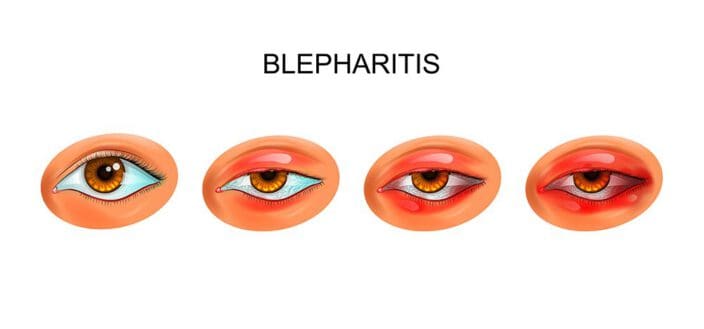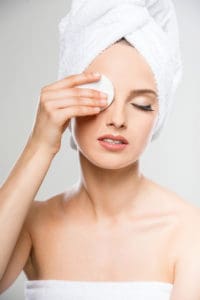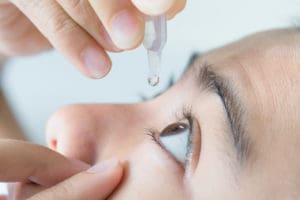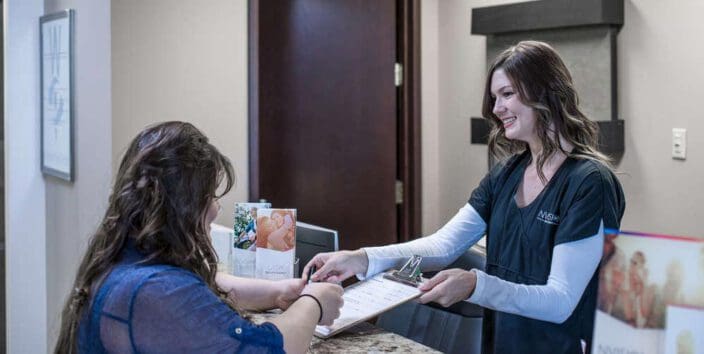Guide to Blepharitis: Effective Treatment & More
Home / Eye Conditions & Eye Diseases /
Last Updated:
Blepharitis causes swelling, itching, and flaking of the skin that surrounds your eyelashes. It’s relatively common, and it’s been associated with other health conditions, such as dandruff and rosacea.
Table of Contents
Often, people with blepharitis are encouraged to start treatment at home. You might be asked to wash your scalp daily, and you might need to scrub your eyelids too. The type of cleaning solution you use on your eyes matters, as some are more effective than others. You might also be encouraged to add fatty acids to your diet by eating more fish or taking vitamin supplements.
Researchers are looking for new ways to help people with blepharitis. Your doctor might suggest antibiotic medications, or they might use therapies like BlephEx or Lipiflow to unclog glands, remove bacteria, or both. Your doctor can help you find a treatment plan that is right for you, and you will stay in touch to make sure it keeps working.

Blepharitis Is Common
According to estimates from Medscape, about 25 million Americans have blepharitis. This medical condition causes swelling of the eyelids, particularly the portion of the eyelid that holds eyelashes. The exterior portion of the eyelid can be impacted by the condition, or the inside of the eyelid can be the portion that swells.
Blepharitis can cause symptoms other people can see, such as:
You deserve clear vision. We can help.
With 135+ locations and over 2.5 million procedures performed, our board-certified eye surgeons deliver results you can trust.
Your journey to better vision starts here.
- Watering eyes.
- Red eyes.
- Greasy-looking eyelids.
- Flaking pieces of skin that stick to eyelashes.
- Crusted eyelashes.
Other symptoms are felt by the person with the condition. You might feel as though your eyes are sticky or gritty, and you might feel a burning sensation in your eyes.
Blepharitis can also cause your eyelashes to point in unusual directions, and the condition can also reduce the amount of tears that lubricate your eyes. When put together, these two issues can lead to corneal ulcers, according to Mayo Clinic.
The American Optometric Association reports that blepharitis on the outside of the eyelid is typically caused by bacteria, such as staphylococcus. Dandruff in your scalp or on your eyebrows can also cause blepharitis symptoms on your eyelids. While it’s less common, tiny mites that live on the surface of the skin can also attack the eyelashes, leading to blepharitis.
Blepharitis on the inside of the eyelid is caused by an irregular production of oil by the glands of the eye. Bacteria can grow nicely in this oily and warm environment. Posterior blepharitis can also be caused by health conditions such as rosacea.
Home Care for Blepharitis

It is important to note that blepharitis is a medical condition. It is not exclusively linked to poor hygiene or squalid living conditions. Even so, doctors often advise patients to begin a blepharitis treatment program by washing the eyelids regularly.
The National Eye Institute recommends applying a warm compress to the eyelids to soften and remove crusts caused by blepharitis. When the crusts are removed and the eyelids are warm, a mixture of water and baby shampoo can be applied via a cotton swab in a scrubbing motion. It’s important to scrub the portions of your eyelid that have eyelashes. That means you will not rub on the surface of your eye or the top of your eyelid that is close to your eyebrows. Your focus should be on the area that holds eyelashes.
You should scrub enough to remove crusts, blockages, and bacteria, but not so hard that you can damage your eyes. Your doctor can show you how to do this cleansing properly, and you should ask questions and ask for demonstrations until you feel comfortable handling this task at home. This does take a bit of dexterity, and if you know you will not be able to clean your eyes properly, you should tell your doctor right away.
For years, doctors have encouraged patients to use baby shampoo as they scrub their eyelids, but new research suggests that specially designed eye washes may do a better job. In a study published in The Ocular Surface, researchers found that baby shampoos seem to harm goblet cells, which play a role in keeping the eye moist. Specialized eye washes do not cause this type of damage, and they may work better for some patients as a result.
A good scrub can help to keep the eye clean and clear, but if blepharitis symptoms involve the inside of the eyelid, you many need to do a little more. After your cleansing, you will also need to perform a gentle massage of the eyelids to help accumulated oil to move out of the glands before a blockage takes hold. Your doctor can help you understand how to massage your eyelids without poking your eye or pressing so hard that you make your eyes ache.
Since some types of blepharitis are associated with dandruff, your doctor may also encourage you to wash your scalp with a medicated shampoo each day. That can keep bacteria that live on your scalp from migrating to your eyelids. If you have rosacea, you may be encouraged to treat that condition at the same time. That can help to keep overall facial inflammation down, which can reduce swelling on your eyelids.
Blepharitis symptoms can come and go, and often, they do not disappear entirely. That means people who have blepharitis might need to keep washing their eyelids for the rest of life in order to keep symptoms under control.
The American Association for Pediatric Ophthalmology and Strabismus suggests that long-term management of the condition might also include adding essential fatty acids, especially omega-3 fatty acids, to the diet. Choosing fish over beef, along with adding a few specialized supplements to daily routines, might be wise.
New Treatments Doctors Can Offer
At one point, doctors could only recommend washes and vitamins to help people with blepharitis. There were no other approved treatments available. Now, things are changing.
Research published in the journal Clinical Ophthalmology suggests that an eye drop with antibiotics, given twice per day for two weeks, can help some people to overcome symptoms of blepharitis. In this study, 6.3 percent of participants had no clinical symptoms after 15 days of treatment, and the healing persisted for as long as six months.

Since not all cases of blepharitis are caused by bacterial cells, it makes sense that not all people with the condition would respond to antibiotic drops. But those who do have bacteria involvement seem to achieve big benefits from the therapy.
The BlephEx treatment is designed to help doctors clean the eyelids of patients with blepharitis. According to an article published in Review of Optometry, the device has a high-speed sponge that can dig deep into the tissues around the eye, and this deep cleaning can offer relief that lasts for six months or longer.
In an article published by Thieme Medical Publishing, researchers examined therapies for people who have blepharitis complicated by demodex mites. They were given tea tree oil topical cleansers, a cleansing foam, or an ointment containing metronidazole. They were also offered oral medications to reduce mite counts. Mite counts were lowest with metronidazole ointment, but none reached mite counts of zero.
Research like this can seem disappointing, but it’s important to note that researchers are still looking for ways to deal with mites that might cause blepharitis. Combining therapies might help, or your doctor may have new therapies for you to try.
If your blepharitis is caused by blocked oil ducts, a therapy involving thermal pulsation might help. According to Medical News Today, this therapy can help to melt away any material that might be obstructing your glands, but it must be done in a doctor’s office. Your doctor may also be able to use pulsed light therapy to open up clogged glands around your eyes.
You deserve clear vision. We can help.
With 135+ locations and over 2.5 million procedures performed, our board-certified eye surgeons deliver results you can trust.
Your journey to better vision starts here.
What Therapy Is Right For You?
In order to determine the best course of action to treat your blepharitis, your doctor will need to examine your eyes, the skin on your face and scalp, and the hair on your eyebrows and scalp. These examinations shouldn’t hurt, and they can give your doctor a good understanding of what is happening with your eyes and your health.
When your examinations are complete, your doctor can begin to draw up a plan of action for treatment. You may begin with at-home care, followed by repeated visits to your doctor to determine if you are getting better.
To track your progress, it might be wise to take photographs of your eyelids every day. You may be able to see subtle changes in how red or crusty your eyes are when you first awaken in the morning, and your doctor might like to see photographic evidence of your success.
If you are not improving with conventional care, your doctor may suggest advanced therapies to get to the root of the problem. This is the point at which you might discuss medications or in-office therapies to ease discomfort and help you to get better. Your doctor should explain your options carefully, so you can make the right choice for your care.
Your doctor is a vital part of your healing plan for blepharitis, and you should make your choice of doctor carefully. We can help. At NVISION, our doctors are excellent clinicians and honest communicators. We can help you understand what’s happening now and what should happen in the future. Contact us to make an appointment with a doctor today.
The Patient Experience

Exceptional outcomes. The gold standard in patient care. The #1 Choice of Eye Doctors®. The Vision For Life promise. That’s what makes the NVISION® experience like no other.
Learn More
You deserve clear vision. We can help.
With 135+ locations and over 2.5 million procedures performed, our board-certified eye surgeons deliver results you can trust.
Your journey to better vision starts here.
References
- Adult Blepharitis. (December 2017). Medscape.
- Blepharitis. (April 2018). Mayo Clinic.
- Blepharitis. American Optometric Association.
- Facts About Blepharitis. (August 2009). National Eye Institute.
- Randomized Double-Masked Trial of Eyelid Cleansing Treatments for Blepharitis. (January 2018). The Ocular Surface.
- Blepharitis. American Association for Pediatric Ophthalmology and Strabismus.
- A Randomized, Double-Masked, Parallel-Group, Comparative Study to Evaluate the Clinical Efficacy and Safety of 1 Percent Azithromycin—0.1 Percent Dexamethasone Combination Compared to 1 Percent Azithromycin Alone, 0.1 Percent Dexamethasone Alone, and Vehicle in the Treatment of Subjects with Blepharitis. (August 2016). Clinical Ophthalmology.
- New Blepharitis Treatments. (October 2014). Review of Ophthalmology.
- Treatment Options for Demodex Blepharitis: Patient Choice and Efficacy. (April 2015). Thieme Medical Publishers.
- Blepharitis and How to Treat It. (January 2018). Medical News Today.
This content is for informational purposes only. It may have been reviewed by a licensed physician, but is not intended to serve as a substitute for professional medical advice. Always consult your healthcare provider with any health concerns. For more, read our Privacy Policy and Editorial Policy.
